275th Anniversary: Andre Zenon Vidrine
The Vidrine Family in LA celebrates the 275th anniversary of Jean Baptiste Lapaise de Védrines’ departure from France and arrival of LA in 2018. It’s a great time to remember and reflect on the 275 years of history of his descendants and the life and family he established in LA.
The first-born child of Zenon Vidrine, Sr. and Marie-Josephine Larose Fontenot was Andre Zenon Vidrine, born in March 1824 at the Quartier dit Baton Rouge (Ville Platte, LA). His father, Zenon, Sr., was 25 and his mother, Marie-Josephine, was 19. When he was born, his great grandparents, Jean Baptiste Lapaise de Védrines and Elisabeth de Moncharvaux – the progenitors of the Vidrine family in Louisiana – had both passed away. However, his grandparents, Etienne Vidrine dit Lapaise (54) and Victoire Soileau (47) – from the second generation of the Vidrine Family in LA – were still living, and the home of his father, Zenon, Sr. was next to theirs.
While he was undoubtedly baptized at St. Landry Church in Opelousas like all Catholic children at that time, the record of his baptism has not yet been found.
The childhood and adolescence of Andre Zenon’s father was as an American, the first generation of the Vidrine Family in Louisiana to grow up as such. By the time Andre Zenon was born, his growth in the late 1820’s and early 1830’s was thoroughly influenced by life in the American south before the Civil War. Growing up on the farm of his father, Zenon, Sr., he helped his father with the duties of the farm and probably those of his grandfather, Etienne dit Lapaise as well.
At the age of 20, Andre Zenon Vidrine married Pauline (Appoline) Carriere (who was 7 years older than him) on October 31, 1844, in Opelousas, LA (Opelousas Cte. Hse. #163). They had six children together between 1845 and 1860.
Andre Zenon and Pauline’s first child was Andre, Jr. (named after his father) born on October 13, 1845, in Ville Platte, LA and baptized at St. Landry Church in Opelousas (St. Landry, v. 4, p. 261).
Two years later, their daughter Appoline (Pauline) (named after her mother) was born on September 30, 1847, in Ville Platte, LA and baptized at St. Landry Church in Opelousas (St. Landry, v. 4, p. 303).
Their third child and second daughter, Adele was born on October 28, 1850, in Ville Platte, LA and baptized at St. Landry Church in Opelousas (St. Landry, v. 4, p. 380).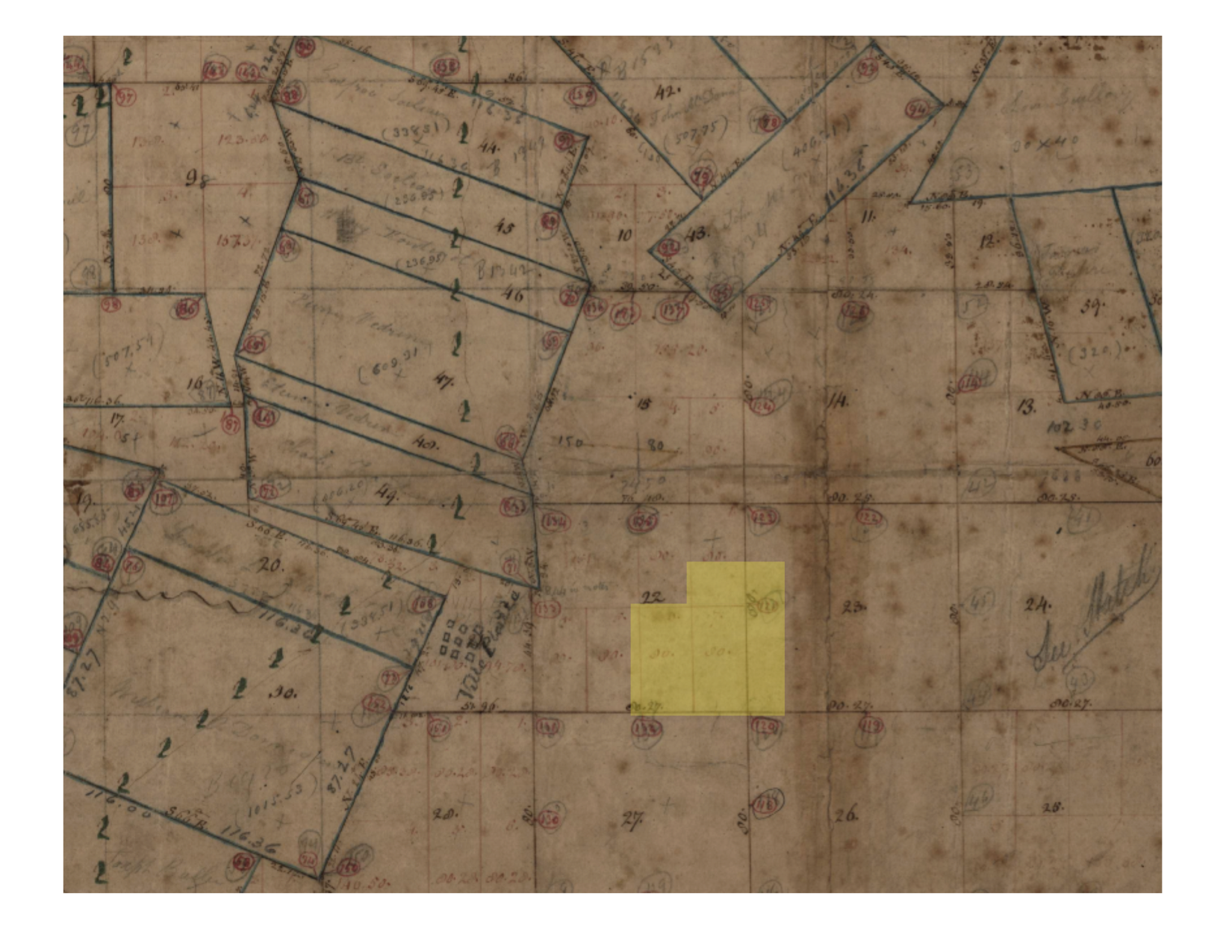
About a year later, on November 17, 1851, Andre Zenon purchased land about one and a half miles east of Ville Platte, LA containing 320.48 acres (#5285; Lot 6 LA No4 S2 E22; Lot 7 LA No4 S2 E22; SE1/4 of NE1/4 LA No4 S2 E22; W½ of SW1/4 LA No4 S2 E23; SW1/4 of NW1/4 LA No4 S2 E23). It was patented on February 20,1857.
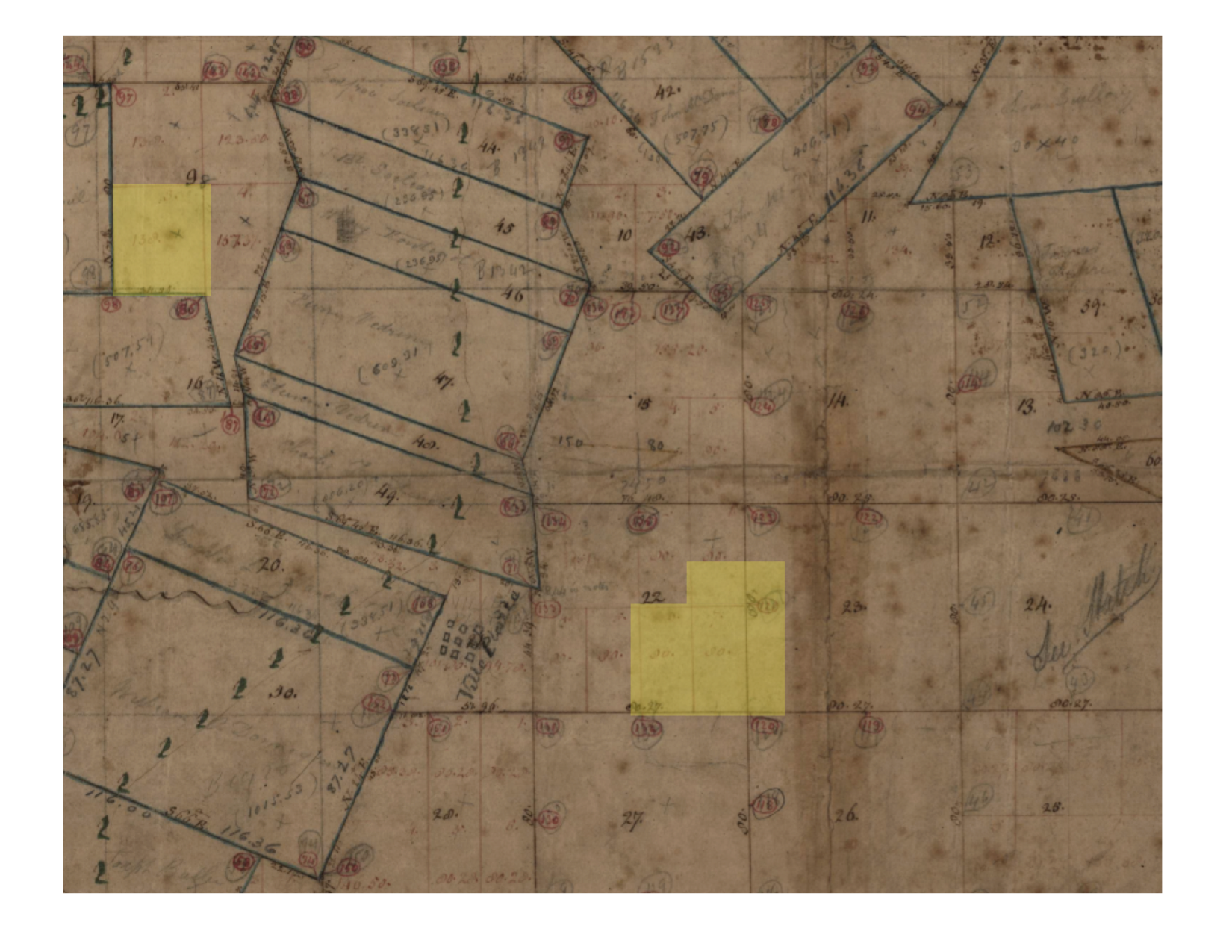 Two years after that, on March
Two years after that, on March
2, 1853, Andre Zenon purchased another section of land to the north west of Ville Platte, LA containing 138 acres (#5422; Lot 3 LA No4 S2 E9). It was patented on September 1, 1853.
The next month on April 8, 1853, Andre Zenon acquired yet more property next to the one he bought in 1851 containing 80.25 acres (#5454 E½ of NW1/4 LA No4 S2 E23). It was patented together with 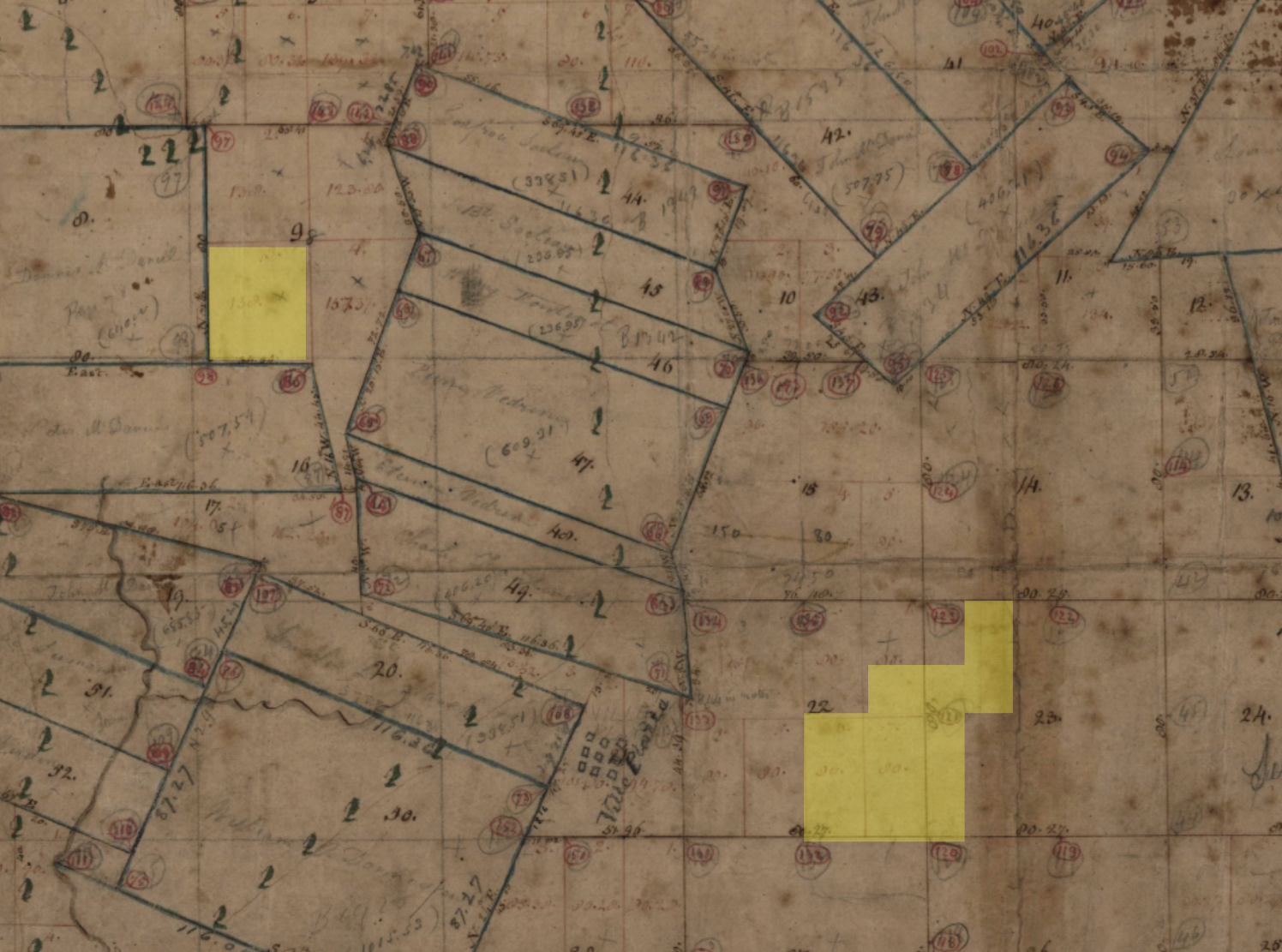 the 1851 land on February 20. 1857.
the 1851 land on February 20. 1857.
It appears from several records that Andre Zenon established a Plantation as a farmer on the land he acquired east of Ville Platte and had the land to the northwest of town, perhaps as a Vacherie.
The third daughter and fourth child of Andre Zenon and Pauline, Adelaide was born in 1855 in Ville Platte, LA.
The following year, their fourth daughter Emelie was born on March 10, 1856, in Ville Platte, LA and baptized 10 days later at Sacred Heart Church by Fr. Beaugier (Sacred Heart v.1,p.51).
 On January 14, 1859, Andre Zenon was appointed as the Administrator of the Succession of Francois A Vidrine, his first cousin (son of Antoine Vidrine and Josephine Ortego). In it, he was described as a Proprietor who lived “near Ville Platte” (confirming the land he purchased up to this point).
On January 14, 1859, Andre Zenon was appointed as the Administrator of the Succession of Francois A Vidrine, his first cousin (son of Antoine Vidrine and Josephine Ortego). In it, he was described as a Proprietor who lived “near Ville Platte” (confirming the land he purchased up to this point).
The fourth daughter of Andre Zenon and Pauline and last of their six children, Elvina was born on January 20, 1860, in Ville Platte, LA and baptized at St. Landry Church in Opelousas (St. Landry v.6, p.108). She was baptized at St Landry in Opelousas (unlike her siblings) because the resident Priest of Sacred Heart Church in Ville Platte had been recalled in 1856 and the Parish came again under the care of St. Landry Church in Opelousas. It was not until later in 1860 that Ville Platte had another resident Priest assigned to Sacred Heart (“The History of Sacred Heart Church”, www.sacredheartvp.com).
In the 1860 US Census, Andre Zenon Vidrine (35) and Pauline Carriere (42) are listed along with their children: Appoline (13), Adele (10), Adelaide (5), Emelie (3), and Elvina (about 6 months old). Their son, Andre, Jr. had married and was not residing with his parents. Andre Zenon was listed as a Planter. His Real Estate value was $10,000 and his Personal Estate was $13,000. He also had eleven slaves.
Unfortunately Andre Zenon’s wife, Pauline (Appoline) Carriere passed away tragically shortly after some time between 1861-1867.
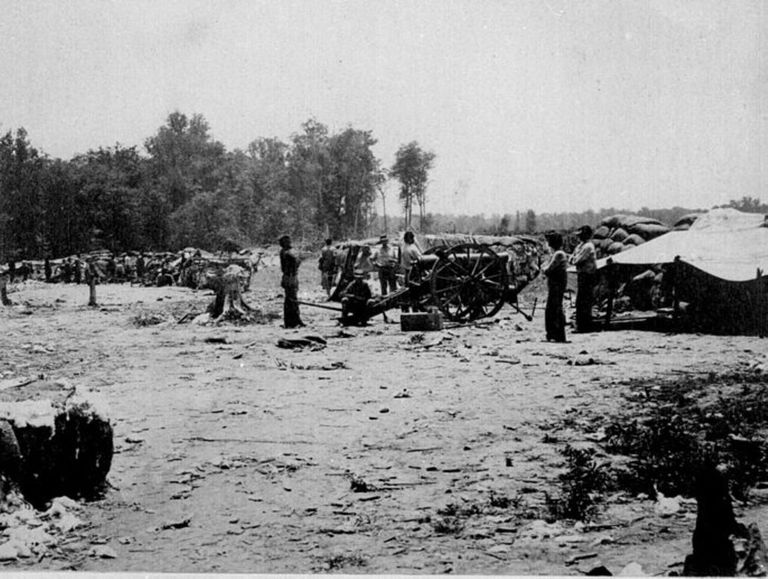 It was during this time that the Civil War began and raged throughout the country. There are no records of Andre Zenon or his father, Zenon, Sr. serving in the Civil War, although his cousins and uncles did. Perhaps he was excused from Conscription because his wife Pauline had died leaving him with five young children at home.
It was during this time that the Civil War began and raged throughout the country. There are no records of Andre Zenon or his father, Zenon, Sr. serving in the Civil War, although his cousins and uncles did. Perhaps he was excused from Conscription because his wife Pauline had died leaving him with five young children at home.
There is another possible reason Andre Zenon didn’t serve in the Civil War. As was mentioned in the article about his father, Zenon, Sr., Andre Zenon Vidrine’s brother in law (brother of his deceased wife, Pauline Carriere) was the well-known leader of the Jayhawkers, Ozeme Carriere. They were a band of outlaws who dodged the Confederate conscription and wanted no part in neither the Confederacy nor the Union armies, but instead went throughout the countryside of south LA terrorizing residents and robbing their food, horses, and guns. This is what Louisiana historian Jim Bradshaw wrote about him:
“Ozeme Carriere, who lived in Bois Mallet, was born May 6, 1831, four
months after his father’s death. His parents, Ursin Carriere and Emilite LaCasse, had seven other children. As a teenager, Ozeme became involved with a group of local toughs who made their living by helping themselves to their neighbors’ livestock, gold, and whatever else they could lay hands upon.
They ranged across Acadiana in pursuit of booty, but they were most often found on the prairies of Acadia and western St. Landry parishes. Carriere learned his trade well, and was firmly established as the leader of this outlaw band by the late 1850s. With his leadership came reports of crimes more vicious than simple robbery. Some people were killed when they resisted the outlaws. That was something that could not be overlooked, and lawmen across the area began tracking the Carriere gang. When the lawmen didn’t get there fast enough, local vigilante groups did. The bandit leader’s older brother, Hilaire, and several other members of the gang were strung up by vigilantes. But Ozeme Carriere remained untouched, and his gang kept acquiring new members – including some women.
When the Civil War reached Acadiana, Ozeme added another dimension to his reputation. He became a “Jayhawker,” a term coined during the Civil War for guerrilla fighters in the South who fought against the Confederacy. The war was not popular in every camp in Acadiana, and a number of men decided that they would rather join Carriere’s gang than be conscripted into the Confederate army.
In 1864, the Confederate government attempted to conscript Creoles of color from the Opelousas area for duty as forced laborers in north Louisiana. The Creoles did not like the idea, and were welcomed alongside white draft dodgers in Carriere’s Bois Mallet band.
Before the Civil War, Carriere had entered into an extra-marital liaison with a sister of Martin Guillory, a prominent free man of color, who in 1864 became Carriere’s chief lieutenant. Carriere also accepted Union deserters as quickly as men skipping Confederate duty.
As his gang grew in size, he had to raid more regularly to keep everyone fed and happy. Luckily for him, the war also brought new opportunities for his raiders – the Confederate encampments where he could find food, tents, horses, and weapons.
The Confederates put out orders to shoot him on sight. But Carriere became a hard man to see, because he was also a hero to the families of those he was hiding from the Confederate draft. At one point, Union General Nathaniel Banks, who commanded the Federal troops that marched through southern Louisiana, sent his Chief of Staff to offer Carriere a commission in the Union army. Carriere would have none of it. He didn’t want any Generals looking over his operations, no matter which side they were on.
As historian Carl Brasseaux and his fellow writers point out in “Creoles of Color in the Bayou Country,” “Under the leadership of Carriere and Guillory, the southwest Louisiana Jayhawkers were a formidable fighting force capable of resisting repeated Confederate efforts to annihilate them. Operating out of camps in the Bois Mallet area…the Jayhawkers controlled most of the southwestern Louisiana prairie country for much of 1863, 1864, and 1865.
“While publicly espousing the Confederate cause, St. Landry’s wealthiest Creoles of Color appear to have privately supported the insurgents. It is hardly coincidental that such leading free men of color as Auguste Donato, fils, capitalized on the Jayhawker presence to move as many of their increasingly valuable cotton bales as possible to relatives’ farms in the Bois Mallet area, where they would be safe from Confederate and Union foragers. Indeed, contemporary civil suits indicate the free men of color were even transporting to Jayhawker territory fencing materials that they acquired from Union forces…”It is equally significant that,” Brasseaux et al continue, “though the Jayhawkers lived off the land by pillaging local farms, particularly those between Opelousas and Church Point, they appear to have scrupulously avoided the caches of agricultural stores hidden by free persons of color at Bois Mallet. Indeed, at a time when Jayhawkers were conducting daring daylight raids against Cajun yeomen, Auguste Donato’s cotton bales sat abandoned but untouched on Evariste Guillory’s Bois Mallet farm. But Confederate soldiers who had gone to fight were angry now over how Carriere was hiding those who would not go. The military joined with the law in hunting him down. The vigilantes found Ozeme’s brother, Ursin, and his sister, Celestine Carriere Saunier, early in 1865. They had each been part of the gang, and were given vigilante justice.
In May 1865, Confederate Lt. Louis Amede Bringier met Carriere and one of his men, Martin Guillory, in the woods near present-day Mallet. When the confrontation was over, Carriere was dead and Guillory was badly wounded. Carriere was 34 years old.
Guillory would recover from his wounds and accept a Union commission as a captain, organizing his Jayhawkers into a unit called the Mallet Free Scouts. But he too would soon be shot down by vigilantes. He was 25 years old when he died.”
(Jim Bradshaw, “Some thought Jayhawker Carriere was really a hero”, Lafayette (LA) Daily Advertiser)
At this point, it is not known if Andre Zenon was in any way associated with Ozeme Carriere. However, the absence of his name among the Civil War soldiers does not rule out that possibility.
The aftermath of the Civil War was brutal for most people in South LA. Many famers, in particular, lost their plantations, wealth, land and even homes during Reconstruction in Louisiana. Andre Zenon Vidrine and his family was no exception.
After the Civil War on December 31, 1868, Andre Zenon Vidrine (44) was remarried to Azelie Guillory (33) (Opelousas Cte. Hse. # 5121-1868). She had been the widow of Jean Philippe Andrus for 10 years. The 1860 Census had listed her a Seamstress by trade. Andre Zenon and Azelie had six children together between 1869 and 1877.
Their first child was William “Willie” was born a little more than nine months after their wedding on October 23, 1869, in Ville Platte, LA and baptized at St. Anthony in Eunice, LA (St. Anthony, v. 1, p. 15). Andre Zenon’s father, Zenon Vidrine, Sr. had died on September 1, 1869 at his home in Duralde, LA. Perhaps the reason Willie was baptized at St. Anthony in Eunice (instead of at Sacred Heart in Ville Platte) was that his family was in Duralde helping Andre Zenon’s mother, Marie-Josephine Fontenot after his father’s death?
The 1870 US Census was taken the next year. Andre Zenon Vidrine (46) appears with his wife, Azelie (35) along with Adelaide (15), Emelie (14), Elvina (10) – daughters of Andre Zenon and Pauline Carriere, as well as the newborn son of Andre Zenon and Azelie, Willie, who was now about 8 months old. Andre Zenon was listed as a Farmer and Azelie was keeping house. Their Real Estate value was now only $1,000 (dramatically lower than in 1860) and their Personal Estate $1,700 (also dramatically lower than in 1860), both reflecting the aftermath of the Civil War and the terrible consequences of the Reconstruction.
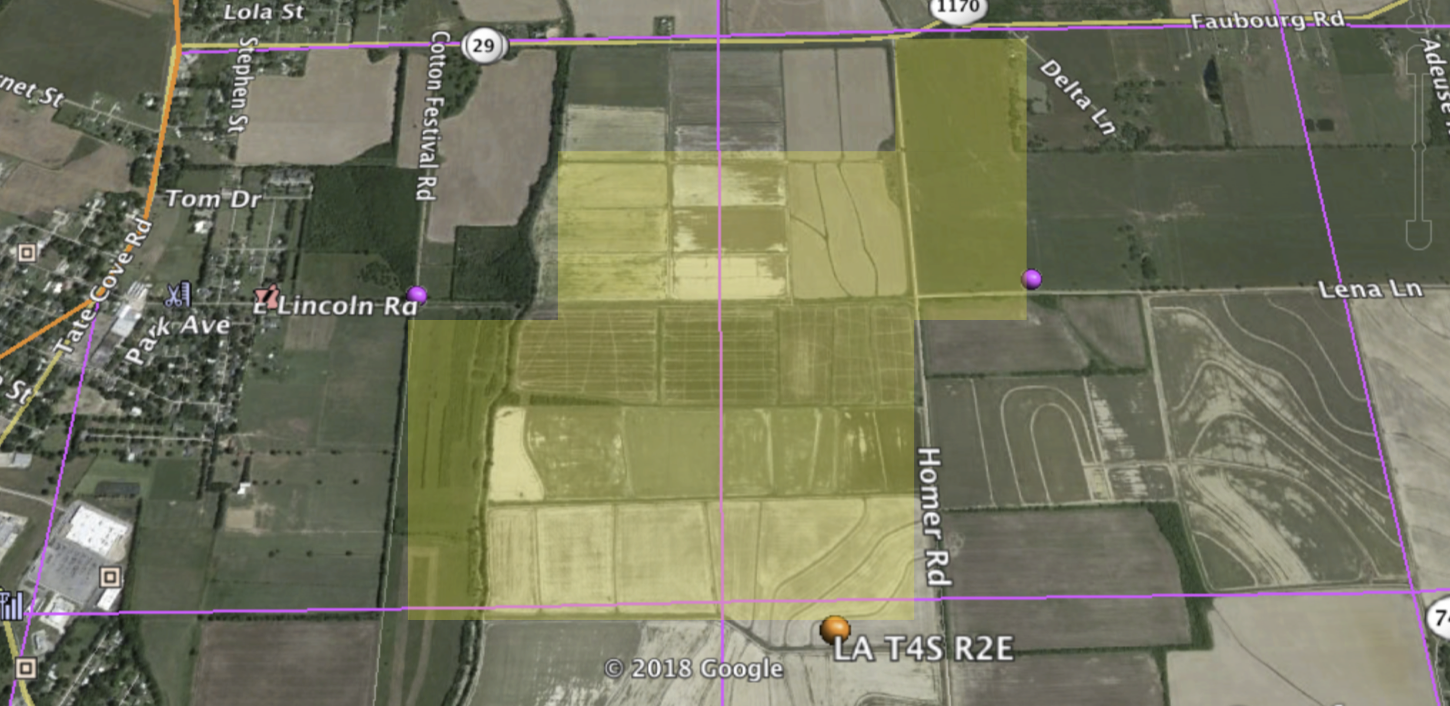 In fact, by the beginning of the next year, on February 4, 1871, a Public Auction was held of part of the Plantation of Andre Zenon Vidrine “containing two hundred acres…situated about one and a half miles from Ville Platte, bounded north by Pierre Veillon, west by Jean Garand, east by D. Johnson, and Defranc or Alexandre Deville” (Sheriff Sale no. 722, 12/31/1870). This appears to be the majority of the 320.48 acres of land Andre Zenon acquired back in 1851 to the east of the town of Ville Platte, LA.
In fact, by the beginning of the next year, on February 4, 1871, a Public Auction was held of part of the Plantation of Andre Zenon Vidrine “containing two hundred acres…situated about one and a half miles from Ville Platte, bounded north by Pierre Veillon, west by Jean Garand, east by D. Johnson, and Defranc or Alexandre Deville” (Sheriff Sale no. 722, 12/31/1870). This appears to be the majority of the 320.48 acres of land Andre Zenon acquired back in 1851 to the east of the town of Ville Platte, LA.
It appears that Andre Zenon and his family remained living on the remainder of his the land (120.48 acres) his Plantation had been on. Later that fall, their second son, Louis Zenon was born there on September 7, 1871. He was baptized two years later with his younger twin brothers on May 18, 1873 at Sacred Heart Church by Fr. Juhel (Sacred Heart, v.2, p.153).
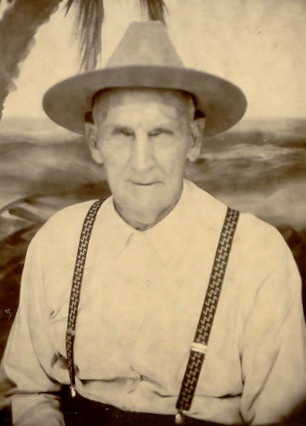 Two years later, Azelie gave birth to twins – their third and fourth boys, Josien (left) and Joseph on March 20, 1873, in Ville Platte. Both Josien and Joseph were baptized at Sacred Heart Church in Ville Platte, LA on May 18, 1873 by Fr. Juhel (Sacred Heart, v.2,
Two years later, Azelie gave birth to twins – their third and fourth boys, Josien (left) and Joseph on March 20, 1873, in Ville Platte. Both Josien and Joseph were baptized at Sacred Heart Church in Ville Platte, LA on May 18, 1873 by Fr. Juhel (Sacred Heart, v.2, 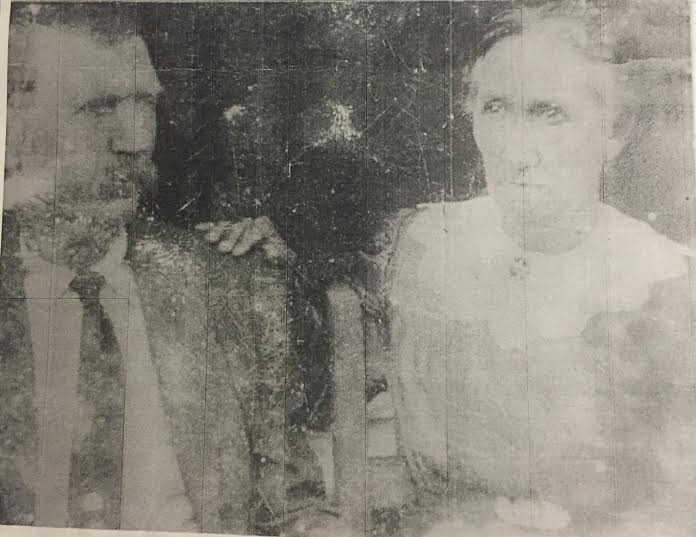 p.153). The godparents of Josien were Homer Andrus and his wife, Elvina Vidrine – Josien’s older half sister (right). Unfortunately, Joseph seems to have tragically died shortly after.
p.153). The godparents of Josien were Homer Andrus and his wife, Elvina Vidrine – Josien’s older half sister (right). Unfortunately, Joseph seems to have tragically died shortly after.
Later that year Andre Zenon’s family would experience more tragedy as Adelaide (daughter of Andre Zenon and Pauline) passed away on October 10, 1873, in Ville Platte, LA, at the age of 18 (Sacred Heart, v.1, p.26).
Two years later, on December 4, 1875, Andre Zenon lost more land, as a Public Auction
was held of “A certain tract of Prairie land…situated at Ville Platte Prairie…containing fifty arpents more or less, bounded north by Defendant (Andre Zenon Vidrine), east by Joseph Derouen, south by Alexander D Deville and southwest by public domain.” (This appears to 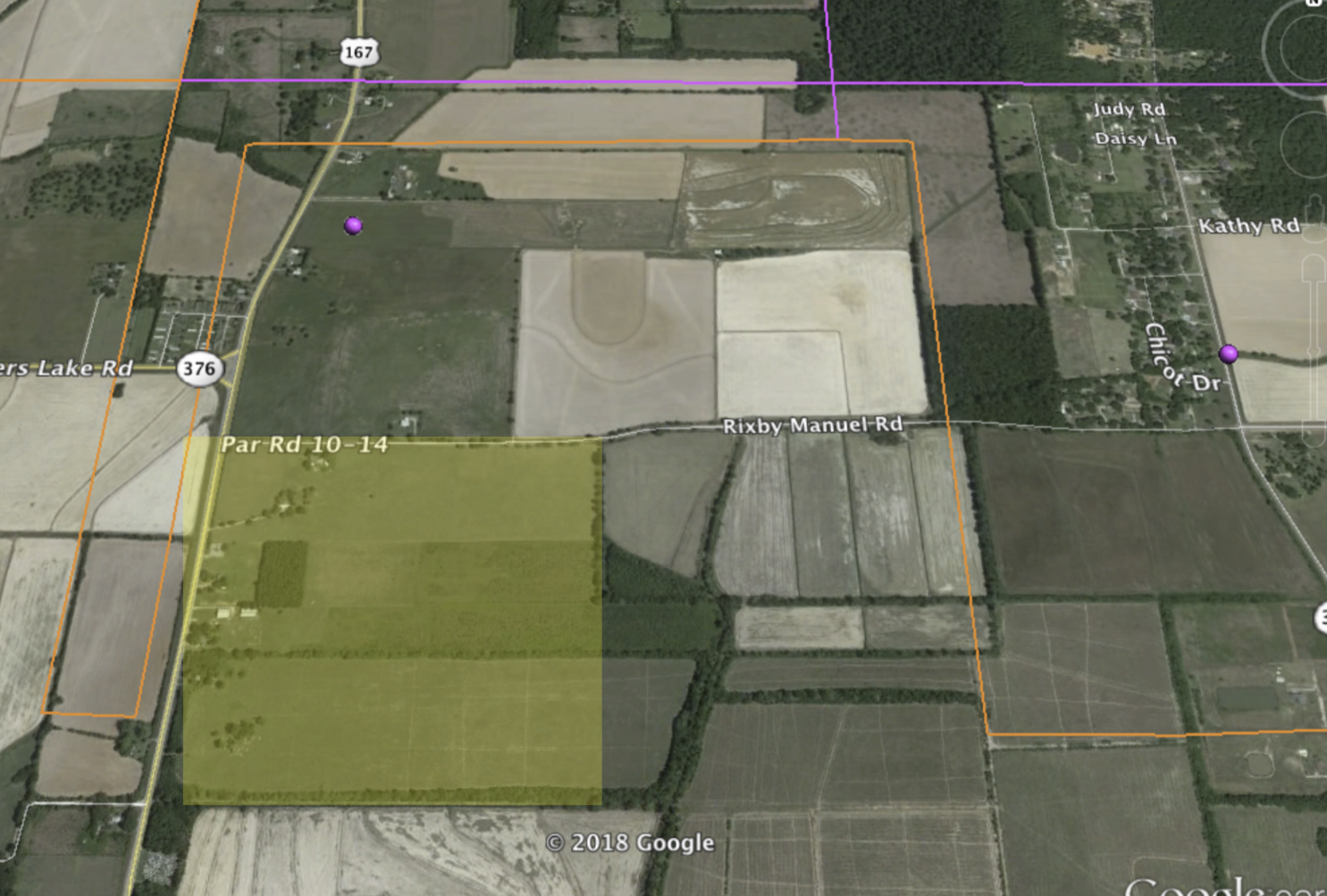 be a little more than 40 of the remaining 120.48 acres he had lost at the Public Auction in 1871.) Also contained in the Public Auction was: “a certain tract of woodland situated on the confines of Ville Platte Prairie…containing one hundred and seventeen superficial arpents more or less, bounded north by Joseph S Fontenot, east by Etienne Vidrine and others, south by M. Daire and William Reed, and west by land belonging to the Estate of Eloise Pitre and others” (Sheriff’s Sale 11/12/1875 #12389). This appears to be about 100 of the 138 acres he acquired to the northwest of Ville Platte back in 1853.
be a little more than 40 of the remaining 120.48 acres he had lost at the Public Auction in 1871.) Also contained in the Public Auction was: “a certain tract of woodland situated on the confines of Ville Platte Prairie…containing one hundred and seventeen superficial arpents more or less, bounded north by Joseph S Fontenot, east by Etienne Vidrine and others, south by M. Daire and William Reed, and west by land belonging to the Estate of Eloise Pitre and others” (Sheriff’s Sale 11/12/1875 #12389). This appears to be about 100 of the 138 acres he acquired to the northwest of Ville Platte back in 1853.
To add to the tragedy, the fifth child of Andre Zenon and Pauline Carriere, Emelie passed away in 1875 in Ville Platte, LA at the age of 19. She was married to Albert Andrus Sr., and they had son, John Andrus, who was under two years old.
The fifth son of Andre Zenon and Azelie, Lastie was born on March 10, 1876, in Ville Platte, LA. He would be baptized two years later on October 13, 1878 by Fr. Jean Francois Raymond (Sacred Heart, v.3, p.53) along with his younger sister, Marie.
The following year, the only daughter of Andre Zenon and Azelie, Marie was born on December 3, 1877, in Ville Platte, LA. She was baptized on October 13, 1878 at Sacred Heart Church in Ville Platte by Fr. Jean Francois Raymond (Sacred Heart, v.3, p.53) with her older brother Lastie.
In the 1880 US Census, Andre Zenon Vidrine (56) is listed as a Farmer along with his wife, Azelie who is listed as keeping house and their children: Willie (11), Louis Zenon (9), Josien (7), Lastie (4), and Marie (3). Also living with them were their nephews and nieces: Emile (13), Ida (9), and Arthur Soileau (7) (children of Aristide Soileau and Hermosa Guillory). By this time, they appear to be living at Andre Zenon’s property to the north west of Ville Platte.
Andre Zenon Vidrine died on September 7, 1898 at the age of 74. His funeral was celebrated the next day by Fr. Chastel at Sacred Heart Church in Ville Platte, LA. The death register at Sacred Heart Church written by Fr. Chastel says that Andre Zenon was: “Buried in the cemetery behind the house of Mr. Vidrine.” This is most likely the Te Mamou Cemetery on Hwy 167 just north of Ville Platte, which is just south of the land that Andre Zenon owned.
Azelie Guillory Vidrine died on October 18, 1918 at the age of 83. Her funeral was celebrated the next day by Fr. Savy at Sacred Heart Church in Ville Platte, LA, and she was buried at the Te Mamou Cemetery just north of Ville Platte.
Andre Zenon Vidrine was my third great grandfather. One neat thing is that in 2018 there are still people living who knew people who knew him!
